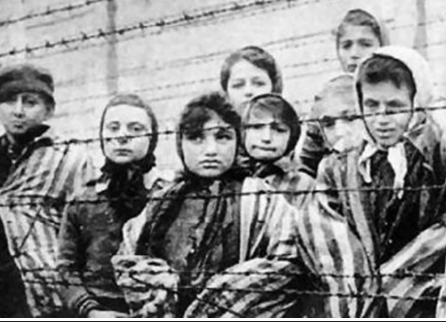
Holocaust in Europe
The mobile killing units – “Einsatzgruppen"
The so-called Einsatzgruppen (Einsatzgruppen der Sicherheitsdienstes und des Sicherheitspolizei) were established in 1938, and used during the invasions of Austria and Czechoslovakia to seize the documentation held by local secret services and state offices, and in the persecution of opponents of the Third Reich.
Following the German occupation of Poland in September 1939, further Einsatzgruppen were formed and ordered to find and neutralise Polish enemies of the Reich. More than 1.5 million people were shot by them, the vast majority of whom were members of the Polish intelligentsia, including patriotic priests, teachers, and Jewish members of the urban population.
In the spring and summer of 1940, during the occupation of France and the Benelux countries, Einsatzgruppen were mainly used according to their original role, for the occupation of secret intelligence headquarters and the seizing of all documentation.
In 1941 when Operation Barbarossa began, four Einsatzgruppe units were established and ordered to ‘neutralise’ enemies of Germany, and to encourage anti-semitism with the aim of initiating a pogrom. However, these units soon ended up competing with each other in carrying out mass murder, intending to clear the areas under their control completely of Jewish inhabitants. They arrived after the occupying Wehrmacht forces had taken control of each city. All Jewish inhabitants were ordered to a designated area, usually on the outskirts of the town, where they were stripped of their belongings, shot and buried on the spot. Those who survived the massacre were buried alive.

By the end of 1943 the four Einsatzgruppe units operating in former Soviet territories (Lithuania, Latvia, Estonia, Belarus, the Smolensk district, Moscow, Ukraine, Crimea and the North Caucasus) exterminated 1.25 million Jewish people, and hundreds of thousands of Soviets, including prisoners of war.
The constant up-close contact with murder brutalised and destroyed the Einsatzgruppe soldiers. This led the Nazi leadership in the second half of 1941 to look for alternative methods. Soon the Einsatzgruppen were provided with gas vans for the extermination of the remaining Jews. [1]
Indroduction of Zyklon B
Auschwitz 1 was established on the outskirts of the Polish town of Oswiecim in 1940. It was built as a prison for the long-term confinement of anti-Nazi elements both in Germany and Poland. They were to be used for forced labour in mining and steel manufacture.
On 3 September 1941 a new extermination method was tested in the 11th block [the prison block] of Auschwitz 1. Using powdered hydrogen-cyanide, originally manufactured as insecticide under the name: Zyklon B, 600 soviet prisoners of war were simultaneously executed. The test was declared ‘a success’, after which the 11th block was adapted and became a temporary gas chamber.

The Wannsee Conference.
Plan for the complete extermination of the world’s Jewish population
January 1942, a conference was held in Wannsee led by SS Obergruppenführer Reinhard Heydrich, leader of the RSHA [Imperial Security Head Office] during this meeting a decision is made about the ‘endlösung’, the extermination of the European Jewry. According to the resolution of the RSHA, ‘Under proper guidance, in the course of the final solution the Jews are to be allocated for appropriate labour in the East. Able-bodied Jews, separated according to sex, will be taken in large work columns to these areas for work on roads, in the course of which action doubtless a large portion will be eliminated by natural causes. The possible final remnant will, since it will undoubtedly consist of the most resistant portion, have to be treated accordingly, because it is the product of natural selection and would, if released, act as the seed of a new Jewish revival [see the example of history]’. The document does not detail what ‘treated’ means, participants however were undoubtedly aware.

Participants decided that “Approximately 11 million Jews will be involved in the final solution of the European Jewish question, distributed as follows among the individual countries:
- Germany 131,800
- Austria 43 000
- Bialystok 400 000
- Protectorate Bohemia and Moravia 74,200
- Estonia – free of Jews
- Latvia 3500
- Lithuania 34000
- Belgium 43000
- Denmark 5600
- France / occupied territory 165 000
- Unoccupied territory 700 000
- Greece 69 600
- Netherlands 160 800
- Norway 1,300
- Bulgaria 48000
- England 33 000
- Finland 2300
- Ireland 4000
- Italy including Sardinia 58 000
- Albania 200
- Croatia 40 000
- Portugal 3000
- Romania (including Bessarabia) 342 000
- Sweden 8000
- Switzerland 18 000
- Serbia 10 000
- Slovakia 88 000
- Spain 6000
- Turkey (European portion) 55 500
- Hungary 742 800
- USSR 5 million
- Ukraine 2 994 684
- White Russia excluding Bialystok 446,484
Following the decision about the complete extermination of the world’s Jewish population, in January 1942 the first gas chamber of the newly built Auschwitz II, next to the Polish village of Birkenau started to operate, and was followed by a second one in the summer of that year.
However this was still not sufficient to carry out the plan, drawn up in Wannsee. Between March and June 1943 the camp was supplied with 4 additional extermination buildings, which made possible the execution of 20,000 people per day.
Deportations from ;European countries
Stages of the Romanian Holocaust [2]
The Pogrom in Bucharest, January 21-23, 1941
The Iron Guard [3] Rebellion of 21-23 January 1941 was the culmination of anti-Semitic violence initiated by members of that unit. Desiring to take over the entire power of the state, the Iron Guard Legionnaires triggered a wave of terror against the Jews, including arrests, mistreatment, assassination, robbery, devastation and burning of temples, synagogues, Jewish institutions, and Jewish businesses and households.
On June 21, 1941, Ion Antonescu [4] gave an order to displace all Jews from rural areas and to concentrate them in ghettos in the county capitals. Columns of Jews travelled tens of kilometers to these new destinations and their properties were looted by the authorities and by the local inhabitants. Once in the county capitals, there was overcrowding and a lack of food which resulted in epidemics of typhoid.
On June 19, an order sent to the National Propaganda Ministry called for the identification of "Jews, Communist agents and sympathizers.
On June 22, the first day of the war, posters were displayed in Iaşi, calling for pogroms, accusing the Jews of collaboration with the Soviet Air Force, stating that Jewish civilians were signalling the planes and guiding them to strategic targets.
On the morning of June 29, a column of Jewish inhabitants from neighbouring villages of Iaşi was escorted to the square in front of the police station. They were massacred. In accordance with the orders of Ion Antonescu, survivors of the massacre were taken to the station to be evacuated. People were crowded into freight wagons which had been used to transport carbide, and the atmosphere inside became suffocating. They headed to Transnistria, a newly occupied part of Romania. From the 5000 people only 1011 arrived alive.
Ethnic Purification Policy in Bessarabia and Bucovina[5], July-September 1941
In the early days after the outbreak of the ahwar, Romanian and German troops broke into the villages and towns of Bessarabia and Bucovina where pogroms were triggered. In just a few days, thousands of Jews were killed in New Sulity, Ciudei, Storojineţ, Banila, Herţa, Vijniţa, Cernăuţi. On July 17, 1941, Romanian and German troops entered Chisinau where there was another massacre, resulting in around 10,000 deaths. The survivors of these pogroms were deported to the River Dnyester, where most of them died either because of scarce food and housing, or because of the hostility of the German troops that at that time controlled Transnistria and refused to receive them. Of the 25,000, less than half survived.
Deportations in Transnistria, 1941-1942
Under the Vienna Agreement signed on 30 August 1940 by the representatives of Romania and Germany, Transnistria was declared Romanian. On September 14, 1941, the Jews of Bessarabia and Bukovina were deported to the camps in Vertujeni, Secureni and Edinet. Convoys of Jews were led by Romanian military officers and escorted by the Romanian “Jandarmi”. The daily march had to cover 30 kilometers and those left behind were executed on the spot. On October 9, more than 26,000 people were deported from Suceava, Câmpulung Moldovenesc, Vatra Dornei, Rădăuţi, Gura Humorului and other towns. In the same month, approximately 9,000 people from Dorohoi were deported, mostly elders, children and women, as men had been taken for forced labour. At the same time, hundreds of Jews from ‘the Old Kingdom’ [6] and southern Transylvania were deported for alleged crimes. In October 1942 mass deportations were suspended.

People deported to Transnistria were left to die through famine and disease. Deportees were crowded into homes deserted during Operation Barbarossa, there was no heating and a complete lack of sanitation. The situation was further aggravated by a lack of food, medicine and a ban on leaving without authorization.
According to some calculations, 115,000 to 118,000 local Jews were murdered in Transnistria, and between 105,000 and 120000 Romanian Jews were killed or died because of the living conditions in the camps and ghettos.
Among those subject to the extermination regime in Transnistria were thousands of Roma families deported following Marshal Ion Antonescu's order in 1942-1943. Of the 24,000 deported Roma (both nomadic and sedentary) only 14,000 survived. [7]
Austria
Before the First World War Austria had a Jewish population of about 192,000. The systematic deportations from the country (as well as from other parts of Greater Germany – the German speaking occupied territories) began in October 1941, when Jewish people were interned in transit camps. About 35 000 people were deported from Vienna to ghettos in Eastern Europe, mostly to Minsk, Riga and Lodz, where they were shot by the Einsatzgruppen. Thousands of Jewish people were sent to concentrations camps in 1942. By November of that year only about 7000 Jewish people remained in Austria, most of them married to Christians. [8]

Bohemia and Moravia
In 1938 the former Czechoslovakia was broken into three different parts. The Sudetenland was incorporated into Germany as a ‘Reichsgau’, Slovakia formally became an independent Republic, and the rest was proclaimed an autonomous protectorate of Greater Germany and, according to the official statement, governed by ethnic Czechs but, in reality, completely under the control of the German leadership.
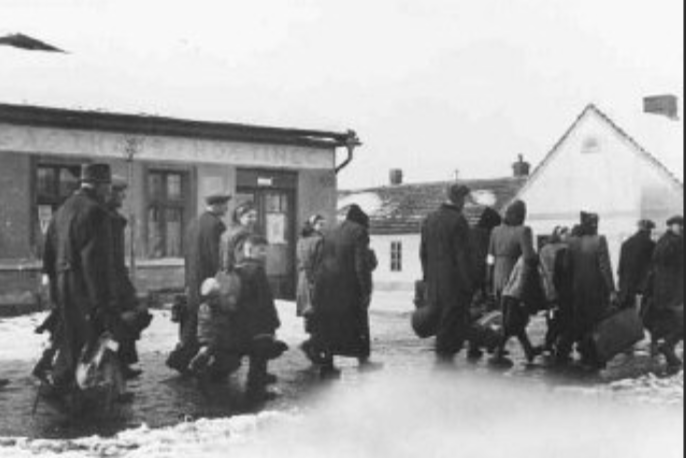
In November 1941 – two month before the Wannsee conference! – Reinhard Heydrich ordered the establishment of the Theresianstadt Ghetto, approximately 60km north of Prague. Between 1941 and 1944 73,603 Jewish people were arrested and collected to Theresianstadt from Prague, Brno, Ostrava, Olomouc and numerous other cities of the Protectorate. Most of them stayed briefly in Theresianstadt, and were transported to the Auschwitz camps. Approximately 71,000 people were killed during the Holocaust in the protectorate, and 14,000 survived.[9]
Latvia
Nazi Germany annexed the country in 1940. During the Second World War it was part of the “Reichskomissariat Ostland”, which included the Baltic states and western Belarus as well. As we mentioned above, in the first year of the occupation the German Einsatzgruppen (together with Latvian forces) massacred most of Latvias Jews. Ghettos were established, the largest of which was located in Riga. Thousands of people were transferred here, and most of them became victims of the now regular massacres by the Einsatzgruppen and German police forces.[10]
Lithuania
In June and July 1941, during Operation Barbarossa the Germans occupied Lithuania and the country was incorporated into the Reich Comissariat Ostland. June and July 1941, detachments of German Einsatzgruppen (mobile killing units), together with Lithuanian auxiliaries, began murdering the Jews of Lithuania. By the end of August 1941, most Jews in rural Lithuania had been shot. By November 1941, the Germans also massacred most of the Jews who had been concentrated in ghettos in the larger cities. The surviving 40,000 Jews were concentrated in the Vilna, Kovno, Siauliai, and Svencionys ghettos, and in various labour camps in Lithuania. Living conditions were miserable, with severe food shortages, outbreaks of disease, and overcrowding
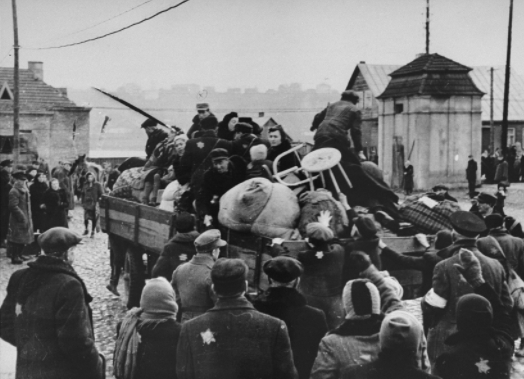
In 1943, the Germans destroyed the Vilna and Svencionys ghettos, and converted the Kovno and Siauliai ghettos into concentration camps. Some 15,000 Lithuanian Jews were deported to labour camps in Latvia and Estonia. About 5,000 Jews were deported to killing centres in German-occupied Poland, where they were murdered. Shortly before withdrawing from Lithuania in the autumn of 1944, the Germans deported about 10,000 Jews from Kovno and Siauliai to concentration camps in Germany.
Soviet troops reoccupied Lithuania in the summer of 1944. In the previous three years, the Germans had murdered about 90% of Lithuanian Jews, one of the highest victim rates in Europe. [11]
Estonia
According to the Molotov-Ribbentrop Agreement the Soviet Union occupied Estonia in 1940. During Operation Barbarossa German troops invaded the country which became part of the ‘Reichkomissariat Ostland’. Einsatzgruppes together with Estonian forces massacred the Jewish population of the country. Following the Wannsee Conference in January 1942 tens of thousands of Jewish people were transferred from different parts of German occupied Europe into Estonian forced labour camps to build military defence fortresses for Germany and to mine shale oil. With the soviet troops approaching in 1944, the Germans evacuated the Estonian camps. Several thousand people were forced on death marches along the Baltic coast. [12]
Belgium
In May 1940 Germany invaded Belgium. The government fled to Britain, where an cabinet in exile was formed. However King Leopold III stayed in the country, and lived under house arrest. Shortly after the occupation a German military administration was introduced. However the Belgian Committee of Secretary Generals (a Belgian administrative panel, appointed by the Germans) refused to cooperate in passing further legislation. At the time of the German invasion there were between 60,000 and 70,000 Jewish residents in Belgium, primarily in Antwerp and Brussels. (lots of them, refugees from Germany). Between 1942 and 1944 the German military police with the assistance of the local civil administration deported approximately 25,000 people from Belgium to Auschwitz. Fewer than 2,000 deportees survived the war. [13]
Denmark
When Germany occupied Denmark on April 9, 1940, the Jewish population was approximately 7,500, accounting for 0.2% of the country's total population. About 6,000 of these Jews were Danish citizens the rest were German and eastern European refugees. Until 1943, the German occupation regime took a relatively benign approach to Denmark. The Germans were eager to cultivate good relations with a population they perceived as "fellow Aryans." Although Germany dominated Danish foreign policy, the Germans permitted the Danish government complete autonomy in running domestic affairs, including maintaining control over the legal system and police forces.
On September 8, 1943, SS General Werner Best, head of the German civilian administrator in Denmark, sent a telegram to Adolf Hitler to propose that the Germans make use of martial law provisions to deport the Danish Jews. Hitler approved the measure nine days later. As preparations proceeded, Best, who had second thoughts about the political consequences of the deportations, informed Georg Ferdinand Duckwitz, a German naval attaché, of the impending deportation operation. Before the final order for deportation came to Copenhagen on September 28, Duckwitz, along with other German officials, warned non-Jewish Danes of the plan. These Danes, in turn, alerted the local Jewish community.
In the intervening days, Danish authorities, Jewish community leaders, and countless private citizens facilitated a massive operation to get Jews into hiding or into temporary sanctuaries. When German police began the roundup on the night of October 1, 1943, they found few Jews. In general, the Danish police authorities refused to cooperate, denying German police the right to enter Jewish homes by force, or simply overlooking Jews they found in hiding. Popular protests quickly came from various quarters such as churches, the Danish royal family, and various social and economic organizations. The Danish resistance, assisted by many ordinary Danish citizens, organised a partly coordinated, partly spontaneous rescue operation.
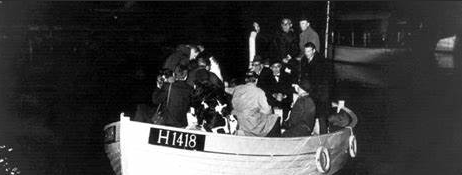
Resistance workers and sympathisers initially helped Jews move into hiding places throughout the country and from there to the coast; fishermen then ferried them to neutral Sweden. The rescue operation expanded to include participation by the Danish police and the government. Over a period of about a month, some 7,200 Jews and 700 of their non-Jewish relatives travelled to safety in Sweden, which accepted the Danish refugees. Boat transports did not stop once the Jewish refugees were safely in Sweden: some continued to bring members of the underground resistance movement to Sweden or smuggle Swedish intelligence agents into Denmark.
Despite the rescue efforts, the Germans seized about 470 Jews in Denmark and deported them to the Theresienstadt ghetto in occupied Czechoslovakia. Most of the deportees were German or eastern European refugees. Despite the fact that many of those deported were not Danish citizens, the Danish authorities and the Danish Red Cross vocally and insistently demanded information on their whereabouts and living conditions. It is likely that the vigour of Danish protests deterred the Germans from transporting these Jews to killing centres in German-occupied Poland. The SS authorities at Theresienstadt even allowed Danish prisoners to receive letters and some care packages. The Danish Red Cross was a key driving force behind the request of the International Red Cross to visit and inspect Theresienstadt, first made in the autumn of 1943. After the Reich Security Main Office
Danish Jews remained in Theresienstadt, where dozens of them died, until 1945. In late April of that year, German authorities handed the Danish prisoners over to the custody of the Swedish Red Cross. Virtually all of the refugees returned to Denmark in 1945. Although a housing shortage required some of them to live in shelters for a few months, most found their homes and businesses as they had left them, since the local authorities had refused to permit the Germans or their collaborators in Denmark to seize or plunder Jewish homes.
In total, some 120 Danish Jews died during the Holocaust either in Theresienstadt or during the flight from Denmark. This relatively small number represents one of the highest Jewish survival rates for any German-occupied European country.[14]
France
Germany occupied France in the summer of 1940. At that time approximately 350,000 Jewish inhabitants lived in the country, more than half of them refugees from Germany and the Benelux States. After the German occupation in 1940 the country was divided in two. Northern and western France became part of the Greater Reich, under a military leadership, while the southern parts were formally free, lead by a puppet government in Vichy, and remained unoccupied until the end of 1942. In the autumn of 1940 the Vichy government enacted a series of anti-Jewish laws, which excluded Jewish inhabitants from public life, occupations in industry, commerce and the arts. Following the Wannsee Conference the first transport left the country from Compiègne on 27th March 1942. On June 27th operations to concentrate Jews in centres in both the occupied and the Vichy zone of France were launched. During the summer they were systematically transferred to concentration camps in Poland, mainly to Auschwitz. By the autumn 1942 42,000 deportees had passed through the Drancy transit camp on the outskirts of Paris. Most of them were refugees, as the Vichy government tried to save their own Jewish population by sacrificing the immigrants. The calculated strategy of the Vichy administration, to collaborate with German deportations in order to gain more independence failed. In November 1942 Germany invaded Vichy France. The south eastern corner of the former “free zone” was handed over to Mussolini. As elsewhere, under Italian leadership serious anti-Semitic legislation was not introduced in this area and there were no deportations. By the end of 1944 77,000 people were transferred from the German occupied zone. Most of them died in the Auschwitz concentration camps [15].
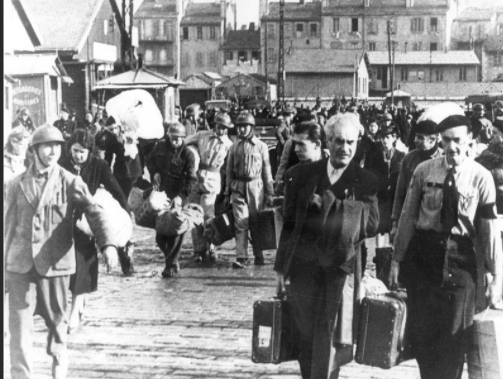
Greece
In October 1940 Italy invaded Greece, but failed to defeat the Greek army. Germany intervened in order to prevent a southern conflict at the time of the planned operation against the USSR scheduled for the Summer of 1941. By April 1941 Axis troops occupied most of the Greek mainland. (the resistance fled to the islands and went on fighting until June). After the surrender the country was divided into three parts. Germany occupied western Macedonia, eastern Thrace along the Greek-Turkish border, the environs of Athens, western Crete, and the Greek islands in the north Aegean close to Turkey. Bulgaria occupied western Thrace. Italy took the remainder of the Greek mainland, eastern Crete, and the Greek islands in the south Aegean, the eastern Mediterranean, the Ionian, and the Adriatic Seas. Germany and Italy jointly occupied Athens, the Greek capital. In the Italian occupied territories the Italian officers ignored the German demands calling for the persecution of the Jewish population. However, in 1943 when Germany invaded Northern Italy her Greek territories were taken into German control as well and the Final Solution was implemented in the area.
Netherlands
In May 1940 German troops occupied the Netherlands. The Queen and the government fled into exile, and a civil administration was established under the supervision of the SS. Arthur Seyss Inquart, former leader of the Austrian National Socialist Party was appointed to Reichskomissar. In the first year of the occupation the Germans gained insight into the - religion based - name and address registers of the inhabitants in the country, and marked Jews with a “J” in their official documents. At the same time the whole population was requested to declare if they had Jewish ancestors. As a result of this process 159, 806 people were registered, including 19,561 from mixed marriages. Approximately 15,000 of them – young men – were taken for forced labour. Foreign and stateless Jews were transported to the concentration camp of Westenbork, which was originally founded by the Dutch authorities in 1939 – as a shelter for European Jewish refugees. From April 1942, registered Jewish inhabitants were ordered to wear a yellow Star of David. The first deportation train left the Netherlands on 15 June 1942. The last transport departed from Westerbork on 13 September 1944. Approximately 101,000 inhabitants were taken to Polish and German concentration camps. Only 5200 survived. [16]
Norway
At the time of the German occupation of the country – April 1940 – approximately 1,600 Jewish people resided in Norway, about 200 of whom were German and Austrian refugees. King Haakoon VII and the Norwegian government went into exile in London. The formal head of the state became Vidukind Quisling, leader of the Norwegian Nazi party. The Germans established their own administration under his official leadership. Between 1940 and 1945 approximately 900 Jewish people escaped to neighbouring and neutral Sweden. Seven hundred and sixty people were deported from the country. Only 25 of them survived the war. [17]
Bulgaria
From the autumn of 1942 Jews were ordered to wear the Star of David although this law was very rarely enforced. The Germans started to negotiate for the deportation of the Bulgarian Jewry in 1942 and were convinced that Bulgaria would easily allow them to be taken out of the country. After several months of negotiations Tsar Boris III and his government allowed the deportation of 20,000 Jewish people which covered approximately the number of the Macedonian and Thracian Jews so it seemed that the Jewish inhabitants of the original Bulgarian territories would remain safe. In the spring of 1943, the Bulgarian authorities arrested 7,144 Macedonians and 4,200 Thracian Jews and transported them, with German support, to the gas chambers of Treblinka. However, the rounding up of Jews in the traditional Jewish communities of the larger Bulgarian cities initiated a wave of protest. For example, an orthodox Christian Bishop turned to the Tsar in an open letter warning him that he would lie on the rails in full regalia if the deportations were not stopped and many letters were addressed to the Prime Minister as well. On the 17th March 1943 the deputy speaker of the Parliament, Dimitar Pesev, submitted a formal protest signed by 42 backbenchers, to the Prime Minister, demanding that all anti-Jewish actions cease. After which the government, with reference to the Hungarian and Romanian situation – where until this time the political leadership had refused German demands to deport their Jewish citizens - and pleading a lack of manpower, stopped the preparations for deportation. However, the danger had not passed and in May of that year Metropolitan Bishop Stephan, head of the Bulgarian Orthodox Church, in his Easter message spoke for the Bulgarian Jews. During the summer Rabbis organised a demonstration in Sophia which was also attended by many non-Jewish citizens.
Under the pressure of anti-Semite politicians in the Bulgarian parliament, the government interned the Jewish inhabitants of the cities in the border areas of the country where unexpectedly the majority of the local inhabitants of these territories were sympathetic to them. Also, in 1942, in an effort to save them from the Germans, Jewish men were assigned to forced labour units.
After these initial attempts there were no further German demands for deportation, so the Jewish inhabitants of the original Bulgarian territories survived the Holocaust. However, after 1920 approximately 12,000 people were sent to concentration camps from the areas regained by Bulgaria [18].
Italy
Before the war Italy had approximately 58, 000 Jewish residents. Despite its alliance with Germany the Italian leadership refused to participate in deportations, in both the country and the Italian occupied territories, therefore between 1941 and 1944 thousands of European Jewish people fled to Italy. In 1943 when Italy surrendered to the Allied Forces, German troops invaded the northern part of the peninsula. They established transit camps at Fossolo di Carpi, approximately 12 miles to the north of Modena, and at Borgo San Dalmazzo, on the French border to hold the Jews before deportation. These preparations had limited success due to the reluctance of the Italian authorities. In all the Germans deported 8,564 people from Italy, Italian occupied France and the islands of Rhodes and Kos. [19]
Slovakia
After 1938 Slovakia formally became an independent state, which joined the Tripartite Act in November 1940. Like Hungary Slovakia also participated in Operation Barbarossa and declared war on the United Kingdom and the Soviet Union in December 1942. In 1940 there were 88,951 Jewish residents in the country. In 1942 Slovakia signed an agreement with the Reich, giving permission to the deportation of the Slovakian Jews. Jews were then systematically transported by the Slovak authorities to the borders, where they were handed overt to the SS. Almost all of them met their death in the concentration camps of German occupied Poland. Only 300 of them survived the war.
In summary we can conclude that:
Deportations of European Jewish residents were carried out in all German occupied countries in Europe.
The national authorities showed effective active resistance in only two of the German occupied countries: Italy and in Denmark. We must note however that the latter had a special status in the Greater Reich, as an “Aryan” country.
Two of the Axis countries Slovakia and Romania and a formally neutral state, Bulgaria conducted deportations without German troops having crossed their borders.
The German leadership had planned for Hungary to be part of the Greater German Reich, as a “Gau”. However, the country was not strategically crucial for Germany until the very end of the war The result being that it was not invaded before 1944. Because of this the Hungary was relatively safe for Jewish people, while they were deported to death camps from most western European countries. However, when the Reich invaded Hungary the national administration rounded-up the exceptionally large Jewish population, in just three weeks. This was unprecedented.
References
[1] Summary of the Yad Vashem Holocaust Centre,
http://www.yadvashem.org/odot_pdf/Microsoft%20Word%20-%206240.pdf
[2] Data from United States Holocaust Museum.
https://www.ushmm.org/wlc/en/article.php?ModuleId=10005447
[3] data of the United States Holocaust Museum
https://www.ushmm.org/wlc/en/article.php?ModuleId=10007323
[4] Data of the United States Holocaust Museum
https://www.ushmm.org/wlc/en/article.php?ModuleId=10005443
further data in:
Ezergailis, Andrew: The Holocaust in Latvia 1941-1944—The Missing Center, Historical Institute of Latvia (in association with the United States Holocaust Memorial Museum) Riga 1996.
[5] Data from United States Holocaust Memorial Museum
https://www.ushmm.org/wlc/en/article.php?ModuleId=10005444
further information:
Arūnas Bubnys, D. Kuodytė: The Holocaust in Lithuania between 1941-1945, Genocide and Resistance Research Centre of Lithuania, 2005.
[6] Data from United States Holocaust Memorial Museum
https://www.ushmm.org/wlc/en/article.php?ModuleId=10005448
[7] Data from United States Holocaust Memorial Museum
https://www.ushmm.org/wlc/en/article.php?ModuleId=10005432
[8] Data from United States Holocaust Memorial Museum
https://www.ushmm.org/wlc/en/article.php?ModuleId=10005209
[9] Data from United States Holocaust Memorial Museum
https://www.ushmm.org/wlc/en/article.php?ModuleId=10005429
[10] Data from United States Holocaust Memorial Museum
https://www.ushmm.org/wlc/en/article.php?ModuleId=10005436
[11] Data from United States Holocaust Memorial Museum
https://www.ushmm.org/wlc/en/article.php?ModuleId=10005460
[12] Joseph Gordon: The Jews in Bulgaria, Washington, 1993. 96.
[13] Data from United States Holocaust Memorial Museum
https://www.ushmm.org/wlc/en/article.php?ModuleId=10005411
[14] Summary of the research project, carried out by the Elie Wiesel National Institute for Studying the Holocaust in Romania, based on the document collection, published by the same institute:
[15] Far right Party and military unit
[16] “conducator” – Prime Minister of Romania
[17] Areas of the USSR with a high Romanian population
[18] Regat - in contemporary Romanian the term referred to the pre-First World War Romanian territories
[19] This chapter is a translation of the summarizing report about the Romanian Holocaust, by the Elie Wiesel Institute, see:
Pictures:
1.Einsatzgruppe in action in Ukraine
2.Auschwitz, Block 11
Source: BBC, Auschwitz drone video of Nazi Concentration Camp, https://www.youtube.com/watch?v=64-pKLhNErE&list=PLZ5s2wJWG-AhavTUtVs5o0QKdTzAkoew6
3.Wannsee, source: ushmm.org
4.Deportations from Transnistria, Source: radiofree.europe
5.Deportations from Austria. source: ushmm.org
6.Deportations from Bohemia and Moravia. Source: ushmm.org
7.Deportation from Kovno ghetto, Source: ushmm.org
8.Danish rescue mission launching to Sweden Source: ushmm.org
9.Deportation from Paris. Source: ushmm.org